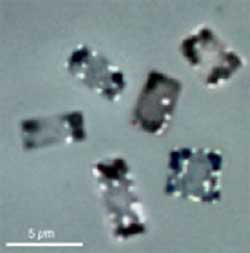Australian scientists have successfully cultured square-shaped bacteria found in salt lakes, a phenomenon that has puzzled researchers for a quarter of a century.
 Research led by doctoral researcher David Burns, Dr. Mike Dyall-Smith, and others from the University of Melbourne’s Department of Microbiology and Immunology has opened the door to extensive investigation into the ecological significance of these unique organisms found in Australian salt lakes.
Research led by doctoral researcher David Burns, Dr. Mike Dyall-Smith, and others from the University of Melbourne’s Department of Microbiology and Immunology has opened the door to extensive investigation into the ecological significance of these unique organisms found in Australian salt lakes.
The research team recently published a report in FEMS Microbiology Letters detailing the first successful culture of ‘Walsby’s square bacteria’ (named after British microbiologist Anthony Walsby, who first discovered them in 1980).
British microbiologist Anthony Walsby first isolated these square-shaped bacteria from a salt lake near the Red Sea in 1980. They are rectangular in shape. Since then, culturing them in laboratories has been a goal for many microbiologists, but all have failed.
These bacteria are the most abundant organisms found in salt lakes, and they are thought to be responsible for the distinct reddish color observed in locations such as the Pink Lakes at Murray-Sunset National Park in Victoria. Unlike other bacteria, they possess a perfect square shape, resembling tiny tiles when viewed under a microscope.
Two research groups led by Henk Bolhuis from the University of Groningen in the Netherlands and Mike Dyall Smith at the University of Melbourne, Australia, have discovered the formula for culturing square bacteria.
 |
Dr. Mike Dyall-Smith |
Dr. Dyall-Smith stated: “They constitute a large portion of the microorganisms found in salt lakes, and their metabolic processes have significant ecological implications as they convert most organic nutrients into other compounds, including greenhouse gases.”
This discovery may also assist scientists in studying life in extremely harsh environments, such as the magnesium-rich oceans of Jupiter’s moons Europa and Ganymede.
For effective research, it is necessary to culture these bacteria in laboratories, but since their discovery 25 years ago, no one has been able to accomplish this.
He mentioned: “This has puzzled environmental microbiologists because the most abundant microorganisms in salt lakes, and the most bizarrely shaped ones ever discovered, cannot be cultured in the lab. Other bacteria in these salt lakes can be cultured, but not this square-shaped species.”
 Dr. Dyall-Smith and his colleagues, despite losing Australian Research Council funding, have recently published the first description of how to culture square bacteria in the laboratory, providing the first and definitive evidence that they are indeed cells just like other bacteria. Dr. Dyall-Smith emphasized that these bacteria are extremophiles, meaning they are adapted to survive in saturated saline conditions, and they belong to a third domain of life known as Archaea.
Dr. Dyall-Smith and his colleagues, despite losing Australian Research Council funding, have recently published the first description of how to culture square bacteria in the laboratory, providing the first and definitive evidence that they are indeed cells just like other bacteria. Dr. Dyall-Smith emphasized that these bacteria are extremophiles, meaning they are adapted to survive in saturated saline conditions, and they belong to a third domain of life known as Archaea.
The key to their culturing process is “the lower the nutrients, the better.” They successfully cultured these bacteria with very low nutrient density because when nutrient levels increase, other faster-growing bacteria overrun the slow-growing square bacteria.
The growth environment must also be extremely saline. Additionally, researchers had to be incredibly patient. Bolhuis’s team took two and a half years to obtain pure cultures of these bacteria. This is because this type of bacteria grows very slowly, with one generation taking 1-2 days to develop (compared to 20 minutes for Escherichia coli).
“We are currently in an intriguing phase because we can study the idiosyncrasies of these organisms, such as the challenges of culturing them, why they thrive in their natural environment, and how they interact with other microorganisms.”
“Why are they square? We do not know, but at least we are on the path to discovering the answer.”



















































